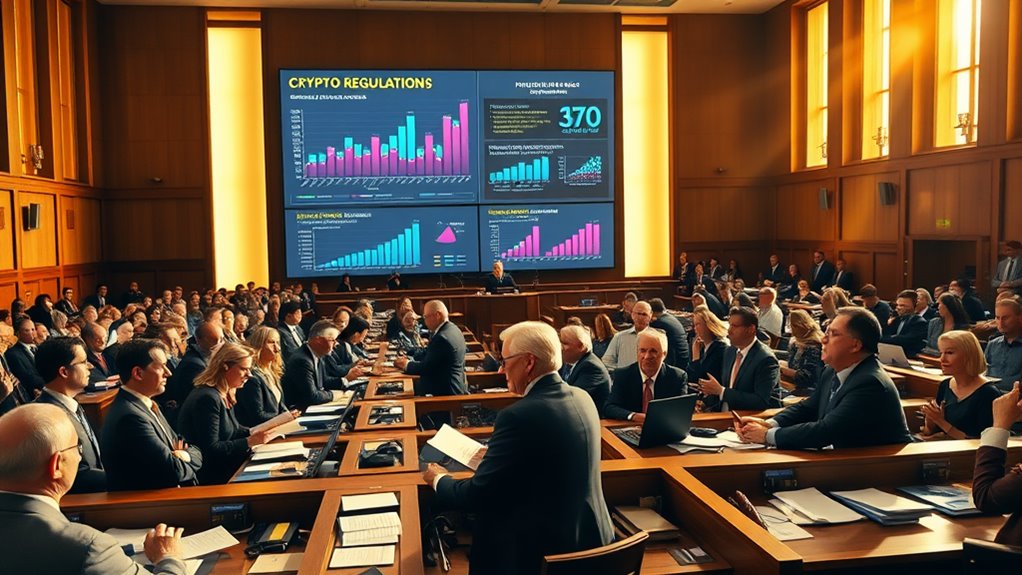
Regulatory Changes Affecting Crypto: What’s New and What’s Next?
Recent regulatory changes in the crypto space highlight a shift in the U.S. landscape. President Trump’s Executive Order emphasizes support for stablecoins and places a ban on CBDCs. The SEC has rebooted its Crypto Task Force to clarify regulations and improve consumer protections. Globally, the EU’s MiCAR regulation is set to enforce stricter rules in late 2024. Alongside these efforts, evolving compliance strategies aim to foster trust and safety in digital assets. Further insights await those intrigued by these developments.
Key Takeaways
- The U.S. has shifted regulatory direction with an executive order banning CBDCs and focusing on U.S. dollar-backed stablecoins and clearer digital asset frameworks.
- The SEC’s Crypto Task Force, led by Commissioner Hester Peirce, aims to enhance regulatory clarity and consumer protection in the crypto landscape.
- Upcoming EU MiCAR regulation will impose stringent bank-like standards on cryptocurrencies and stablecoins, prioritizing consumer protection across the European market.
- New FDIC guidance allows banks to engage in cryptocurrency activities without prior approval, fostering confidence in digital asset management.
- Compliance strategies are evolving, emphasizing enhanced risk management, robust KYC protocols, and regular security audits to build user trust in crypto environments.
Recent US Executive Actions on Digital Assets

In recent years, significant executive actions have been taken in the United States to shape the landscape of digital assets.
President Trump signed an executive order on January 23, 2025, aimed at strengthening U.S. leadership in digital financial technology. This order revoked prior policies, including Executive Order 14067, and introduced a ban on Central Bank Digital Currencies (CBDCs).
It emphasized support for U.S. dollar-backed stablecoins and established a Working Group within the National Economic Council. This group is tasked with developing a clear regulatory framework for digital assets, focusing on market structure, consumer protection, and risk management.
These actions signal a shift towards fostering growth and innovation in the cryptocurrency sector while ensuring oversight and clarity in regulations.
Rebooting the SEC Crypto Task Force

The recent executive actions in the United States have set the stage for a renewed focus on regulatory clarity within the cryptocurrency market. The SEC has rebooted its Crypto Task Force, now led by Commissioner Hester Peirce, aiming to resolve existing uncertainties and enhance regulatory frameworks for crypto assets. This task force will actively engage with both public and private stakeholders to guarantee consistent enforcement strategies.
In light of these developments, the task force will also consider how consumer protection measures can be better integrated into the evolving landscape of digital assets.
| Objectives | Actions Taken | Future Plans |
|---|---|---|
| Token Classification | Clarifying if digital tokens are securities | Roundtables on DeFi topics |
| Staking Regulation | Addressing staking treatments | Exploring sandbox programs |
| Disclosure Regimes | Developing tailored offerings | Engagement with stakeholders |
| Regulatory Clarity | Rescinding SAB 121 for custody | Open submissions for feedback |
Global Regulatory Developments and Their Impact

As global interest in cryptocurrencies continues to rise, regulatory developments are becoming increasingly significant in shaping the landscape of digital finance.
The European Union’s MiCAR regulation, set to take effect in December 2024, will enforce bank-like standards on stablecoins and cryptocurrencies, emphasizing consumer protection.
The EU’s MiCAR regulation, effective December 2024, will impose bank-like standards on cryptocurrencies, prioritizing consumer protection.
In contrast, the United States is exploring varied legislative paths, creating potential regulatory divergence.
Countries in Asia, like Singapore and Japan, have established progressive frameworks that encourage innovation while safeguarding investors.
Meanwhile, Brazil’s Cryptoassets Act aims to curb scams and enhance regulation through its central bank.
Integration of Banking and Crypto Regulations

The integration of banking and cryptocurrency regulations is becoming increasingly important as new guidance from the FDIC emerges.
This guidance outlines risk management requirements that banks must follow when handling digital assets, ensuring a safer environment for both institutions and consumers.
Additionally, interagency collaboration efforts are underway to create a more cohesive regulatory framework that addresses the unique challenges posed by the intersection of traditional banking and crypto activities. As institutions seek to navigate this evolving landscape, the anticipation of regulatory clarity will play a crucial role in fostering confidence among investors.
New FDIC Guidance
With the recent reversal of previous policy, banks are now allowed to engage in cryptocurrency activities without needing prior approval from the Federal Deposit Insurance Corporation (FDIC).
This change enhances regulatory clarity and encourages banks to innovate within the crypto space. Previously, banks faced lengthy approval processes that stifled their ability to participate in crypto activities.
Under the new guidance, institutions can engage in crypto-asset custody, trading, and maintain stablecoin reserves. They can also participate in blockchain payment systems and conduct lending related to cryptocurrencies.
The American Bankers Association has welcomed this shift, noting it will improve customer access to crypto services.
The FDIC plans to collaborate with other agencies to provide further guidance on integrating crypto into banking practices.
Risk Management Requirements
Risk management requirements have become a vital focus as banks integrate cryptocurrency activities into their operations.
The Office of the Comptroller of the Currency (OCC) has altered its guidance to encourage innovation, allowing banks to engage in crypto activities without prior supervisory approval. However, this shift necessitates a strong emphasis on risk management practices.
Banks must navigate various challenges, including operational risks, cybersecurity threats, and the complexities of illicit finance. Effective monitoring solutions, such as real-time compliance tools and blockchain analytics, are essential for mitigating these risks.
Additionally, adapting traditional financial crime controls to the unique characteristics of cryptocurrency is important for ensuring compliance and maintaining the safety and soundness of banking operations in this evolving landscape.
Interagency Collaboration Efforts
As banks increasingly engage with cryptocurrencies, interagency collaboration among U.S. banking regulators has become essential for establishing consistent guidelines. Recent changes reflect a unified effort to streamline the crypto landscape.
Key developments include:
- OCC Reforms: The Office of the Comptroller of the Currency (OCC) has removed requirements that hinder banks from exploring crypto opportunities.
- FDIC Updates: The Federal Deposit Insurance Corporation (FDIC) now permits banks to engage in crypto without prior approvals, focusing on risk management.
- Interagency Coordination: Agencies like the OCC, FDIC, and Federal Reserve are aligning their policies for clearer regulations.
- Regulatory Clarity: A shared approach supports the safe adoption of cryptocurrencies, promoting mainstream integration into banking practices.
These efforts foster a more favorable environment for financial institutions.
Legislative Efforts in the US Crypto Landscape

Recent developments in the United States have highlighted the ongoing legislative efforts surrounding the cryptocurrency landscape, particularly as regulatory frameworks continue to evolve.
The second Trump administration has shifted focus to support digital assets, while bipartisan efforts aim to clarify the roles of the SEC and CFTC in overseeing cryptocurrencies.
Remarkably, the repeal of the Biden Administration’s ‘DeFi Broker Rule’ marks a significant shift. Key proposals like the STABLE Act and GENIUS Act aim to establish clearer guidelines for stablecoin issuance.
Despite strong bipartisan support, challenges remain in defining agency roles and managing state regulations.
As the 2024 elections approach, the crypto industry’s influence may shape future legislation, emphasizing the need for regulatory clarity to maintain U.S. competitiveness in digital assets. Furthermore, the increasing adoption of stablecoins for digital payments is expected to drive legislative urgency as lawmakers seek to streamline crypto integration into the financial system.
Evolving Compliance Strategies for Crypto Exchanges

As the regulatory landscape for crypto exchanges continues to evolve, adaptations in compliance strategies are becoming essential.
Enhanced risk management practices are being implemented to address emerging threats, while collaboration with regulatory bodies is critical for ensuring adherence to new guidelines.
These strategies aim to create a safer environment for users and promote trust within the cryptocurrency ecosystem.
Regulatory Framework Adaptations
The evolving regulatory framework for cryptocurrency exchanges reflects the need for compliance strategies that adapt to a rapidly changing landscape.
Many jurisdictions present unique challenges, requiring exchanges to navigate a complex global environment.
Key adaptations include:
- Global Regulatory Landscape: Different countries have varied regulations, complicating compliance efforts.
- Regulatory Clarification: Initiatives like the EU’s MiCA regulation aim to provide clearer guidelines.
- Technological Integration: The use of blockchain and AI enhances transaction monitoring and security measures.
- Stakeholder Engagement: Increased communication between exchanges and regulators is essential for effective regulation development.
As the landscape evolves, the rise of decentralized stablecoins is likely to influence compliance requirements and risk management strategies.
These adaptations demonstrate the importance of evolving compliance strategies in response to ongoing regulatory changes, ensuring that cryptocurrency exchanges can effectively meet their obligations while fostering innovation.
Enhanced Risk Management Practices
Evolving compliance strategies for cryptocurrency exchanges increasingly focus on enhanced risk management practices. These strategies aim to protect users and guarantee adherence to regulatory standards. Implementing robust Know Your Customer (KYC) protocols and Anti-Money Laundering (AML) measures is vital. Additionally, exchanges conduct regular security audits, utilize multi-factor authentication, and educate users on security practices to mitigate risks. Keeping software and apps up to date ensures users benefit from the latest security patches to fend off potential threats.
| Risk Management Practice | Description |
|---|---|
| KYC Protocols | Verifying user identities |
| AML Measures | Preventing illicit activities |
| Security Audits | Identifying vulnerabilities |
| Multi-Factor Authentication (MFA) | Enhancing access security |
| User Education | Teaching best security practices |
Collaboration With Regulatory Bodies
Collaboration between cryptocurrency exchanges and regulatory bodies is crucial for developing effective compliance strategies. This partnership fosters an environment where regulations can evolve alongside the industry.
Key aspects of this collaboration include:
- Regulator-Industry Dialogue: Regular communication helps create practical compliance frameworks.
- Constructive Feedback: Exchanges provide insights that allow regulators to refine their policies for the crypto sector.
- Coordinated Enforcement: Global efforts against fraud illustrate a shift toward cooperative regulatory strategies.
- Education and Training: Ongoing education for compliance teams guarantees they remain updated on evolving regulations.
Future Trends in Regulatory Approaches

How will regulatory approaches to cryptocurrency shape the future of the industry?
The evolving regulatory landscape suggests a trend toward balancing innovation with necessary oversight. In the U.S., the SEC’s Crypto Task Force aims to clarify uncertainties, potentially enhancing investor confidence and encouraging market participation.
Globally, countries are adopting varied strategies, from strict bans to thorough frameworks like the EU’s MiCAR, which emphasizes investor protection and market stability. As nations recognize the economic potential of cryptocurrencies, changeable approaches may emerge, fostering innovation.
Efforts to define security statuses and improve compliance will likely lead to increased market transparency, ultimately shaping a more secure and robust cryptocurrency marketplace. These trends signal a progressive shift toward a more regulated yet innovative crypto environment. Additionally, the rise of decentralized finance solutions could further influence regulatory considerations, as authorities seek to address the implications of this emerging sector.
The Role of Technology in Shaping Regulations

As technology advances, it plays an essential role in shaping the regulations surrounding cryptocurrency. Various technological innovations enhance compliance and address regulatory challenges. Key elements include:
- Blockchain Analytics Tools: Platforms like Chainalysis monitor transactions for anti-money laundering compliance.
- AI Integration: Artificial intelligence enhances oversight capabilities, improving regulatory frameworks.
- Multi-Party Computation Wallets: These wallets guarantee high security for digital assets, addressing regulatory concerns.
- KYC and AML Procedures: Technology streamlines Know-Your-Customer and Anti-Money Laundering processes, vital for compliance.
Furthermore, the rapid pace of technological advancements often creates complexities in regulation, making it necessary for regulators to adapt continually while balancing innovation and oversight. Additionally, AI-powered smart contracts are emerging as a vital tool for regulatory compliance, offering dynamic solutions that can adjust to changing legal requirements.
This dynamic interplay between technology and regulations will shape the future of the cryptocurrency landscape.
Frequently Asked Questions
How Will These Changes Affect Crypto Prices in the Short Term?
The anticipated regulatory changes are likely to stabilize crypto prices in the short term by reducing uncertainty, fostering investor confidence, and potentially attracting institutional interest, all of which can positively influence market dynamics and investment volumes.
What Are the Penalties for Non-Compliance With New Regulations?
Penalties for non-compliance with new regulations can include substantial financial fines, administrative actions, reputational damage, operational bans, and prolonged regulatory oversight, greatly impacting both individual companies and the broader cryptocurrency market.
Will Crypto Taxes Change With New Regulatory Guidelines?
The future of crypto taxes remains uncertain, with ongoing discussions about potential shifts. Although proposals for tax reductions exist, actual changes depend on legislative actions, IRS guidelines, and broader regulatory trends that continue to evolve.
How Can Individual Investors Stay Informed About Regulatory Updates?
Individual investors can stay informed about regulatory updates by subscribing to newsletters, following reputable financial news sources, engaging with legal experts, utilizing government resources, and participating in industry conferences for direct insights and discussions.
Are There Any Upcoming Deadlines for Compliance With New Regulations?
Upcoming compliance deadlines remain unclear across jurisdictions, with various regulations being implemented. Companies must adapt to evolving requirements, particularly around AML and CFT measures, while watching for specific timelines as legislation progresses globally.
Conclusion
In conclusion, the landscape of cryptocurrency regulation is undergoing significant transformation. Recent executive actions and legislative efforts are guiding the path toward a more structured environment. As compliance strategies evolve and global developments unfold, a delicate balance between innovation and oversight continues to emerge. The interplay of technology and regulation plays an essential role in shaping future policies. Ultimately, these changes aim to create a safer, more transparent marketplace for digital assets and their users.












